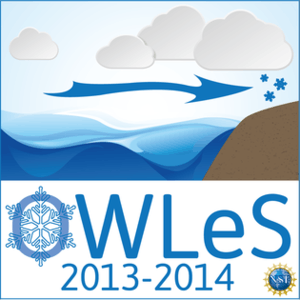OWLeS
The Ontario Winter Lake-effect Systems (OWLeS) was a field project focused on three modes of lake-effect snow: Short-fetch, long-fetch, and downstream coastal and orographic effects.[1] The project was conducted along Lake Ontario in the Great Lakes region and in the Finger Lakes region of upstate New York. OWLeS occurred in two field phases, one in December 2013 and another in January 2014.[2] The project is a collaborative effort of nine universities and the Center for Severe Weather Research and is funded by the National Science Foundation (NSF).[3]
| Ontario Winter Lake effect-Systems (OWLeS) | |
|---|---|
 | |
| Location | Lake Ontario, SUNY Oswego |
| Owner | SUNY Oswego |
| Established | 5-21 December 2013, 4-29 January 2014 |
| Funding | NSF |
| Status | Research Phase |
| Website | http://www.owles.org/ |
Principal investigators
- David Kristovich, Adjunct Associate Professor, Director of Atmospheric Sciences Group, University of Illinois at Urbana–Champaign
- Bart Geerts, Associate Professor, University of Wyoming
- Richard Clark, Dept. Chairman and Professor of Meteorology, Millersville University
- Jeffrey Frame, Clinical Assistant Professor, University of Illinois at Urbana–Champaign
- Neil Laird, Associate Professor of Atmospheric Science, Hobart and William Smith Colleges
- Kevin Knupp, Professor, University of Alabama in Huntsville
- Joshua Wurman, President, Center for Severe Weather Research
- Karen Kosiba, Research Scientist, Center for Severe Weather Research
- Nicholas Metz, Assistant Professor of Geosciences, Hobart and William Smith Colleges
- Todd Sikora, Professor, Millersville University
- Jim Steenburgh, Professor, University of Utah
- Scott Steiger, Associate Professor, State University of New York at Oswego
- Justin Minder, Assistant Professor, State University of New York at Albany
- George Young, Professor, Pennsylvania State University
gollark: Ah, so we could have messaging, yes.
gollark: Also, upside-down-ness must be heritable.
gollark: I have an upside-down mint x tinsel checker which just looks bad due to the right-way-up mints.
gollark: What about upside-down mints showing in lineages?
gollark: If you breed the "CB Prizes" on April Fools' you get an upside-down dragon!
References
- "Ontario Winter Lake-effect Systems (OWLeS)". University of Wyoming. Retrieved 1 February 2014.
- "OWLeS: Ontario Winter (OW) Lake-effect Systems (LeS): December 2013-January 2014". OWLeS. Archived from the original on 11 March 2014. Retrieved 1 February 2014.
- Dybas, Cheryl (18 November 2013). "Scientists brave Old Man Winter to dig out secrets of lake-effect snows". NSF News. The National Science Foundation. Retrieved 1 February 2014.
External links
This article is issued from Wikipedia. The text is licensed under Creative Commons - Attribution - Sharealike. Additional terms may apply for the media files.